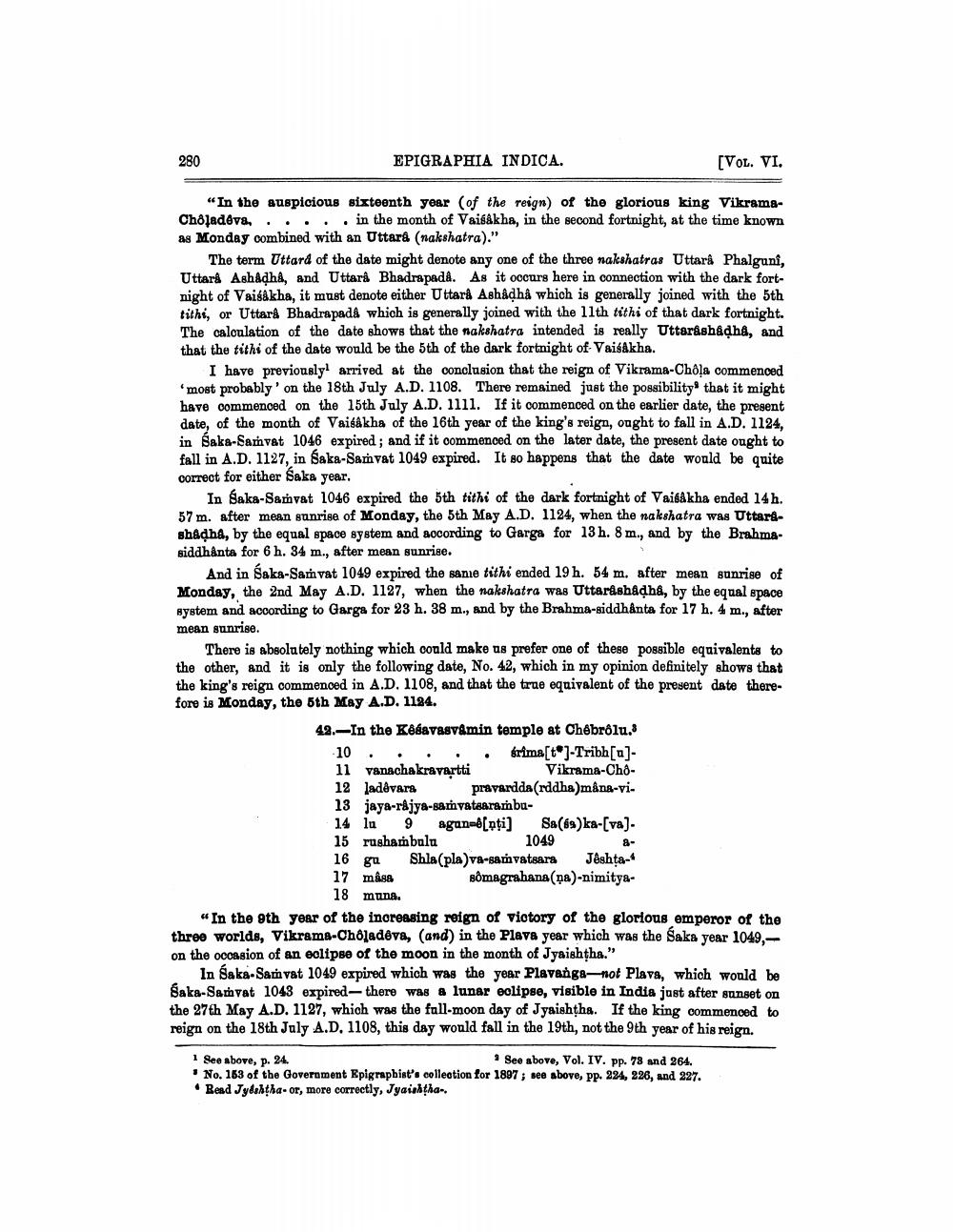________________
280
EPIGRAPHIA INDICA.
[VOL. VI.
"In the auspicious sixteenth year of the reign) of the glorious king VikramsCholadova, ..., in the month of Vaisakha, in the second fortnight, at the time known as Monday combined with an Uttard (nakshatra)."
The term Uttard of the date might denote any one of the three nakshatras Uttara Phalguns, Uttara Ash&dha, and Uttara Bhadrapada. As it occurs here in connection with the dark fortnight of Vaisakha, it must denote either Uttarå Ashådhå which is generally joined with the 5th tithi, or Uttara Bhadrapad& which is generally joined with the 11th tithi of that dark fortnight. The calculation of the date shows that the nakshatra intended is really Uttaráshidha, and that the tithi of the date would be the 5th of the dark fortnight of Vaisakha.
I have previously arrived at the conclusion that the reign of Vikrama-Chola commenced most probably on the 18th July A.D. 1108. There remained just the possibility that it might have commenced on the 15th July A.D. 1111. If it commenced on the earlier date, the present date, of the month of Vaisakha of the 16th year of the king's reign, ought to fall in A.D. 1124, in Saka-Samvat 1046 expired; and if it commenced on the later date, the present date ought to fall in A.D. 1127, in Saka-Samvat 1049 expired. It so happens that the date would be quite correct for either Saka year.
In Saka-Samvat 1046 expired the 5th tithi of the dark fortnight of Vaisakha ended 14 h. 57 m. after mean sunrise of Monday, the 5th May A.D. 1124, when the nakshatra was Uttarashadha, by the equal space system and according to Garga for 13h. 8 m., and by the Brahmasiddhanta for 6 h. 34 m., after mean sunrise.
And in Saka-Samvat 1049 expired the same tithi ended 19 h. 54 m. after mean sunrise of Monday, the 2nd May A.D. 1127, when the nakshatra was Uttarashadhå, by the equal space gystem and according to Garga for 23 h. 38 m., and by the Brahma-siddhanta for 17 h. 4 m., after mean sunrise.
There is absolutely nothing which could make us prefer one of these possible equivalents to the other, and it is only the following date, No. 42, which in my opinion definitely shows that the king's reign commenced in A.D. 1108, and that the true equivalent of the present date therefore is Monday, the 5th May A.D. 1124.
42.-In the Kesavasvamin temple at Chébrôlu.
-10 . . . . . Srima[t]-Tribh[o]11 vanachakravartti
Vikrama-Cho12 laddvara pravardda(rddha)måna-vi. 13 jaya-råjya-samvatsarambu14 la 9 agan-b[nti) Sa(na)ka-[va). 15 rushambula
1049816 gu Shla(pla)va-samvatsara Jeshta-4
sômagrahana(na)-nimitya18 muna. “In the oth year of the increasing reign of viotory of the glorious emperor of the three worlds, Vikrama-Chladeva, (and) in the Plave year which was the Saka year 1049,on the ocoasion of an eclipse of the moon in the month of Jyaishtha."
In Saka Samvat 1049 expired which was the year Plavanga-not Plava, which would be Saka-Samyat 1043 expired- there was a lunar eclipse, visible in India just after sunset on the 27th May A.D. 1127, which was the full-moon day of Jyaishtha. If the king commenced to reign on the 18th July A.D. 1108, this day would fall in the 19th, not the 9th year of his reign.
17 mass
1 See above, p. 24.
See above, Vol. IV. pp. 78 and 264. No. 163 of the Government Epigraphist's collection for 1897; see above, pp. 224, 226, and 227. • Read Jydahtha-or, more correctly, Jyaishtha.




